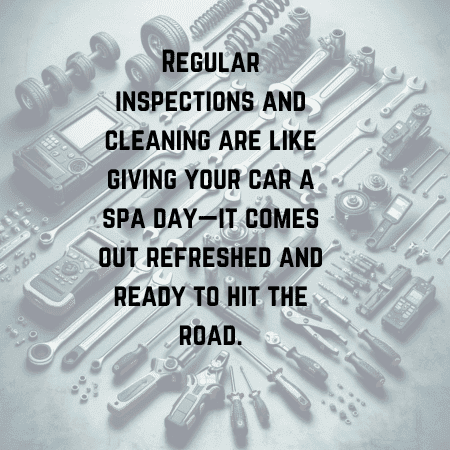You’re driving along and suddenly, that annoying service suspension system light comes on. It’s like your car’s way of saying, “Hey, something’s up!” But no worries, clearing this issue is doable. In this article, I will explain how to clear the service suspension system. So keep on reading…
How To Clear Service Suspension System? First off, you’ll want to check your car’s manual to understand what the light means for your specific car. Then, take a peek under your car to see if anything looks out of place – like leaking fluid or damaged parts.
If everything seems alright, try giving your car a little shake to see if you notice any unusual movements. Sometimes, a loose or worn-out part could be causing the problem. If you’re still stumped, it might be time to take a trip to the mechanic.
warning signs of the service suspension system of the vehicle
Here are the warning signs that your service suspension system needs a little TLC:
1- Bumpy Ride:
If you start feeling every little imperfection on the road, it’s like your suspension has taken a coffee break when it should be on duty.
This could be due to worn-out shocks or struts that are no longer effectively dampening the road impact. It’s not just about comfort; a bumpy ride can also affect your control and handling.
2- Nose Dive or Rear Squat:
When you hit the brakes, your car should gracefully come to a stop without the front end nosediving or the back end squatting like it’s trying to touch the ground.
This is a clear indication that your shocks or struts are struggling. They’re responsible for controlling the weight transfer during braking, and if they’re worn out, your car might resemble a seesaw rather than a smooth stop.
Not only does this impact comfort, but it also affects braking efficiency and control.
3- Car Leans or Tilts:
Your suspension is designed to keep your car level during turns, distributing the weight evenly. If it leans excessively, it’s likely due to issues with the springs or other suspension components.
Proper suspension is not just about aesthetics; it’s a safety feature, that ensures stability and control while navigating curves.
4- Uneven Tire Wear:
When you notice tire treads resembling a mountain range, it suggests that your suspension isn’t distributing the weight properly. This can lead to premature and irregular tire wear, compromising both safety and fuel efficiency. It’s like telling your tires to carry a heavy backpack on one side only – they’ll wear out faster on that shoulder.
5- Bouncing After a Stop:
You come to a stop, and suddenly your car starts doing the bunny hop. This is a clear sign that your shocks or struts are on vacation when they should be working hard.
Shocks and struts are there to control the rebound after your car hits a bump or stops.
If they’re worn out, they lose their ability to keep the car steady. So, the bouncing after a stop is like a neon sign saying,
6- Loud Clunking or Knocking Sounds:
If it starts making loud clunks or knocks, especially when you hit a pothole or a bump, your suspension components might be having a full-blown tantrum. It could be worn-out bushings, loose bolts, or failing shock absorbers.
7- Difficulty Steering:
If you find yourself putting in extra effort to turn the wheel, your suspension system might be playing the role of the uncooperative sidekick.
The issue could be with the power steering system or worn-out components making the steering mechanism less responsive.
9- Fluid on the Ground:
Finding mysterious puddles under your car isn’t a magical manifestation; it’s a sign that something in your suspension system is not holding it together.
Leaking suspension fluid is like your car shedding tears, and it’s usually a sign that your shocks or struts are on the verge of a breakdown.

Must Read
- Can You Drive Without a Muffler? Pros & Cons Of Removing Mufflers
- Is It Safe To Drive Without Power Steering?
- Airbag Light Comes On And Off While Driving – Reasons & Solutions
- Will Vinegar Damage Car Paint? Potential Risks Of Using Vinegar
How To Clear Service Suspension System
Clearing or resetting the service suspension system in a vehicle often involves addressing the underlying issue that triggered the warning. However, it’s important to note that not all vehicles have a user-resettable function for suspension system warnings.
Here’s a general guide, but keep in mind that specific steps may vary based on your vehicle make and model:
Step 1: Identify the Issue
Before attempting any reset, it’s crucial to identify the root cause of the suspension system warning. This might involve inspecting the suspension components, checking for leaks, or consulting the vehicle’s manual for specific guidance.
Step 2: Check for Loose or Disconnected Sensors:
Some suspension systems rely on sensors to monitor various parameters. Ensure that all sensors connected to the suspension components are securely in place. If any are loose or disconnected, fixing the connection might resolve the issue.
Step 3: Inspect Suspension Components:
Examine the visible parts of the suspension system, such as shocks, struts, springs, and control arms. Look for signs of damage, leaks, or wear. If you find any issues, you may need to replace or repair the damaged components.
step 4: Battery Disconnect (for some vehicles):
In some cases, disconnecting the vehicle’s battery for about 15-30 minutes can reset various systems, including the suspension system. This should be done cautiously, ensuring you have access to any necessary security codes for your car’s audio system or other electronic features.
step 5: Use a Diagnostic Tool:
Many modern vehicles have onboard diagnostic systems that can be accessed using a diagnostic tool or scanner. Plug in the tool to the OBD-II (On-Board Diagnostics) port and check for specific suspension-related trouble codes. Some diagnostic tools allow you to clear these codes and reset the system.
step 6: Consult the Owner’s Manual:
Always refer to your vehicle’s owner’s manual for model-specific instructions on resetting the suspension system or clearing warning lights. It may provide details on a specific sequence of actions or steps to follow.
Remember that clearing a suspension system warning is just a temporary solution if the underlying issue isn’t addressed. Always prioritize safety, and if you’re unsure, seek professional assistance.

DIY Suspension System Maintenance
You don’t need to be a mechanic to do some basic maintenance; a little DIY love goes a long way.
So, here’s the deal:
Regular Inspection and Cleaning:
Now and then, take a peek under your car. Check out the shocks, struts, and springs – these are like the unsung heroes working hard to keep your ride smooth. Look for leaks or any signs of wear. And don’t forget those bushings and control arms; they might be shy, but they play a crucial role. If they look a bit worse for wear, it might be time to show them some attention.
Lubrication of Moving Parts:
Think of your car’s moving parts as joints that need a bit of oiling. Grab some grease and hit those lubrication points – ball joints, tie rod ends, and wherever else your manual suggests. It’s like giving your car a joint massage. Use the right kind of lubricant, though – you wouldn’t put lotion on sore muscles, right?
Timely Replacement of Worn-Out Components:
If you hear strange clunks and rattles, or your ride feels more like a rollercoaster, it might be time to change things up. Shocks and struts are like your car’s posture – if they’re slouching, your ride quality suffers. And those bushings? They’re like the unsung heroes keeping everything together. If they’re looking weary, it’s time to bring in the replacements.
Proper Wheel Alignment:
Misaligned wheels can lead to uneven tire wear and a wonky steering experience. Keep an eye out for signs if your steering wheel is pulling to one side or your tires are wearing unevenly, it’s like a signal from your car to get aligned.
So, remember, a happy suspension system equals a happy ride. Treat your car well, and it’ll return the favor with a smooth, joyful journey.
You May Find Helpful
- What Happens If My Drive Shaft Breaks While Driving?
- How To Start A Car With A Bad Crankshaft Sensor?
Conclusion
Effectively clearing a service suspension system requires thorough diagnosis, proper maintenance, and timely repair of any identified issues. By following recommended procedures and seeking professional assistance when needed, you can ensure the safety and optimal performance of your vehicles on the road.
